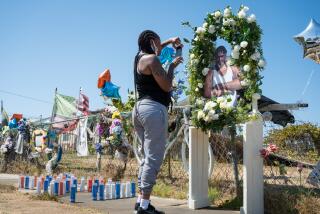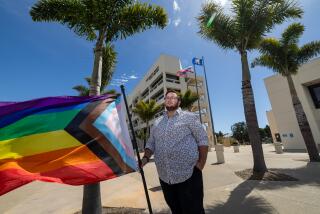O.C. Seeks to Defuse Racial Tensions
HUNTINGTON BEACH â It started with the intimidation and name calling that sometimes punctuates life in this generally laid back surf town: A couple of in-your-face skinheads cruising their stomping ground with a beer buzz, confronting minorities about âwhite power.â
But on this February night, the harassment veered sharply to violence, when one youth pulled out a hunting knife and stabbed a Native American man 27 times, a beach attack so frenzied that the assailantâs accomplice was also wounded.
George Mondragon, 20, survived the assault, which came just one week after what authorities said was an unprovoked slaying of a Vietnamese American man in Tustin, an attack also being investigated as a hate crime.
Orange County civic leaders have responded with a chorus of revulsion, calling the incidents freakish displays of rage in a county whose changing racial landscape has created ongoing tensions.
Hate crime statistics appear to support the contention that such attacks are rare: There were 175 reported hate crimes in 1995--about the same number as in the previous three years. Homicides and physical assaults were just a small part of the total.
But some minorities who live in predominantly white enclaves of the county say the harassment that led to Mondragonâs stabbing is all too common. They lead lives, they say, peppered with epithets and petty humiliations.
Many county residents think of the high-profile hate crimes as isolated incidents, said Pat Callahan, executive director of Orange County Together, a group formed in the wake of the 1992 Los Angeles riots to encourage interethnic dialogue.
âThey donât realize that itâs happening to people who are going to the store. They donât realize that itâs happening in the grocery line. Itâs these sort of daily, subtle insults that add up over time. The big high-profile incidents are symptoms of a caldron underneath--our social caldron.â
On Thursday, Orange County Together will launch its first âDay of Dialogueâ in an Orange County city, turning Garden Grove into the site for dozens of discussions on racial diversity. Talks will take place in churches, temples, businesses, private residences, community organizations, hospitals and other centers across the city.
For James Lawrence, 41, chief electrical inspector for the city of Huntington Beach, such efforts must address common harassment. Lawrence said he has been called âniggerâ by a band of drunk skinheads who told him to âgo back to Africa.â A ranting Neo-Nazi teenager has flipped him off as he drove down Main Street in a city vehicle, he said.
His daughter, 16-year-old Giana Lawrence, sits at a Huntington Beach High School desk with a swastika engraved in it, and opens her used English textbook to read a former studentâs scrawl: âThere should be no black people on the planet.â
The recent racial attacks have brought back haunting memories of James Lawrenceâs childhood in Biloxi, Miss., where he witnessed a lynched classmate hanging in a tree and a drowned girl found floating face-down in the pool at his elementary school. Both African Americans were murdered during the racial upheaval of the Deep South in the early 1960s.
âI come all the way out here, and there are all these . . . skinheads,â said Lawrence, who has little hope the cityâs mood will change.
Although experts on racial conflict emphasize that harassment only rarely escalates into violence, they say the name-calling and aggressive confrontation lay the groundwork for such outbursts.
According to the Orange County Human Relations Commission, skinheads and other white supremacists were responsible for the majority of reported hate incidents in 1995--committing 102 of the 175 crimes and targeting African Americans and Jews in the largest numbers.
Most of the crimes appear to be committed by juveniles or young adults, according to Rusty Kennedy, the commissionâs executive director.
Huntington Beach Mayor Dave Sullivan said city officials take the attacks seriously, and plan to unveil a policy next week that condemns all acts of hate. But he emphasized that the city is safe.
âUsing the FBI [statistics] for the past two years, weâve been selected as [among the safest cities] in America in the category of cities over 100,000,â he said.
Todd B. Nicholson, president of the Orange County Business Council, said he does not consider Orange Countyâs racial tensions serious.
âThere probably arenât communities anywhere in the country that donât have isolated incidents,â he said.
But others point to a small number of youths who seem to be practicing hate with an unparalleled brazenness.
*
The suspected assailants of Mondragon began their evening with verbal abuse, police say. Mondragon tried to flee when they confronted him, but one youth knocked him to the ground and the other attacker pulled out the knife.
Mondragon survived with stab wounds to the chest, liver, back, neck, colon and hands. Thien Minh Ly, 24, was not as fortunate. A week earlier, the former UCLA student leader was found stabbed to death on the Tustin High School tennis courts where he had been practicing in-line skating.
Investigators later arrested 21-year-old Gunner J. Lindberg and Domenic Christopher, who has turned 18 since the slaying. According to police search warrants, Lindberg allegedly wrote a letter to a former prison buddy after the killing, boasting that he âkilled a Jap the other day.â Prosecutors say they may file a hate crime enhancement in connection with the murder.
Last month, a 19-year-old Laguna Niguel man who carried Hitler quotations and a white supremacist cartoon in his wallet was convicted of murder and a hate crime as the accomplice in the 1994 fatal shooting of a 44-year-old African American man outside a Huntington Beach McDonaldâs restaurant. The 20-year-old gunman had already pleaded guilty to murder and hate crime charges.
The victim, Vernon Fluornoy, and his wife had moved to the coastal city from Hollywood after the 1992 riots to get away from urban troubles.
Last week, an Orange County jury found Chad Salisbury, 27, of Los Alamitos guilty of a hate crime and assault with a deadly weapon in connection with an attack on an Anaheim man of Asian Indian descent.
Mark Sanjay David, 25, was beaten unconscious last summer outside an Orange punk rock club by skinheads who first shut the venue down by roughing up a black guitarist on stage, according to police and the victimâs father, Albert David.
âThey noticed my son and said, âOh look what we have here,â â said Albert David, 55, a handyman who has lived in Orange County since 1981. âOne of them said, âTell us which is the super-Aryan race. The answer you give could save your life.â â
Then they dragged Mark David off and beat him with metal pipes--injuring him so severely he spent several days in intensive care and still undergoes physical therapy, his father said.
Underlying such violence, authorities say, is a far more common landscape of insults and threats.
âI can always feel the tension, like I donât belong here,â said 18-year-old Khalilah Slaughter, an African American resident of Huntington Beach who stepped out on a recent night with her Puerto Rican boyfriend and was confronted by a white man with a knife who called her companion âa nigger.â
A deep sense of not belonging has forced Slaughter into an independent study schooling program to avoid attending regular high school.
Such harassment is not limited to Huntington Beach. A mixed race couple who bought a townhouse in Anaheim Hills earlier this month received an anonymous letter last week addressed to âDear Mismatch.â
The letter berated the couple for âhow much our neighborhood has depreciated sense (sic) the white boy and the niger (sic) moved in. . . . We have heard people like you are like roaches, you travel in packs and infest every neighborhood you move to.â
The recipient, 27-year-old Monique Frith, said the hate mail has deepened her resolve to stay in the neighborhood. But it has also made her regretfully suspicious of her neighbors. Police are investigating..
âI donât want to pinpoint one person,â she said, âbut I look at people and itâs making me wonder, âCould it really be them?â â
More to Read
Sign up for Essential California
The most important California stories and recommendations in your inbox every morning.
You may occasionally receive promotional content from the Los Angeles Times.











